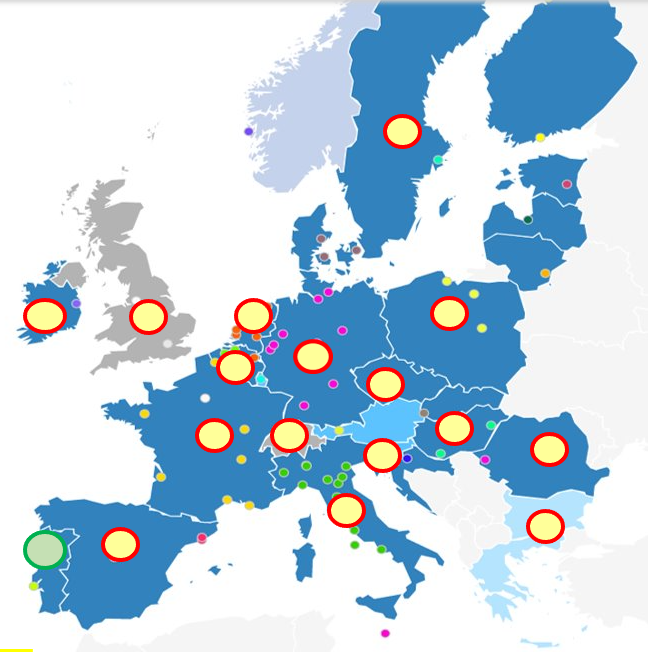What is an ePAG advocate?
In 2016, EURORDIS and the European rare disease community established 24 European Patient Advocacy Groups (ePAGs) aligned to the clinical scope of each ERN. Today, there are over 280 ePAG to represent the wider patient community in the development of ERNs.
What is the role of an ePAG advocate?
The role of ePAG is to represent the voice and interests of their patient community and act as the bridge between this community and the ERN. ePAG have an official permanent mandate to represent ePAG member organisations. They liaise with these organisations to ensure true and equitable representation of the patient voice by participating in the Board and sub-clinical committees of their respective ERN.
To know more about the
How to become an ePAG advocate?
Membership of ePAGs is open to all rare disease patient organisations (EURORDIS members and non-members based in the European Union). ePAGs can only benefit from the flow of ideas between a range of member organisations and advocates.
The recruitment of these advocates is ongoing to ensure that patients are fully represented in the governance of each and every ERN. Patient advocates have already been elected to numerous ERNs but additional applications are welcome for all networks.
If you are interested in learning more about ERN-ITHACA ePAGs, please contact ERN-ITHACA Project Manager Anne (anne.hugon@ aphp.fr).
The ERN-ITHACA Patient Council & Advisory Board
Patient Board is an elected body consisting of 5 ePAGs. It is part and parcel of ERN-ITHACA’s governance and thus participates in each Workgroup or transversal activities and is represented in both the Executive Committee (2 representatives: chair and co-chair) and the Board (5 representatives). Through this organisation, ITHACA aims to maintain a high degree of cooperation between ePAGs and other National or European lay public or patients’ organizations at all levels of decision making and to ensure that all the ERN activities include patients and their families.
In addition, the Patient Council holds an annual face-to-face meeting and several WebEx meetings at a frequency fixed by the Council itself.
To know more about our ePAGs activities and mission, you can read the Patient Advisory Board’s Terms of Reference HERE.


Patient Advisory Board
- Chair: Dorica Dan, Romania
Romanian Prader Willi Association
- Co-chair: Tanja Zdolšek Draksler, Slovenia
IDefine Europe (Kleefstra Syndrome)
- Katarzyna Swieczkowska, Poland
Polish Assocciation for Persons with Intellectual Disability,
- Sue Routledge, United Kingdom
Pitt Hopkins
- Tomasz Grybek, Poland
Borys the Hero Foundation
Patient Council Members
- Ammi Andersson, Sweden – RBU, the Swedish national Federation for children and youth with disabilities
- Ioel Detton, France – Noonan Syndrome Association
- Gabor Pogany, Hungary – Rare Diseases Hungary – HUFERDIS Hungarian Williams Syndrome
- Carole Herman, Amis de ADNP, Paris, FR; caroleheman2012@gmail.com
- Katarzyna Swieczkowska, Polish Assocciation for Persons with Intellectual Disability, Gdansk, PL
- Papatya Alkan, IF International Federation for Spina Bifida and Hydrocephalus, NL/UK
- Pietro Marinelli, Associazione Smith Magenis – ASM17, IT
- Annalisa Scopinaro, Associazione Persone Williams Italia, UNIAMO, IT
- Sandrine Daugy, Génération 22, FR
- Gerritjan Koekkoek, Cdls World federation (Cornelia Delange), NL
- Tomasz Grybek, Borys the Hero Foundation, Gdansk, PL
- Erika Stariha, European Foundation for SATB2-Associated Syndrome, SI
- Nora Leonardi AGO2 Association ago2.org, CH
- Sylvia Roozen International Federation for Spina Bifida and Hydrocephalus, BE
- Inés Fernández, Ulibarri Kleefstra syndrome, SP
- Tanja Zdolsek Kleefstra syndrome IDefine Europe, SI
- Georges Papadopoulosn ANGELMAN SYNDROME GREECE ASSOCIATION, EL
- Alejandro Doval, Asociación KIF1A España, SP
- Ana González Hernández, CTNNB1 Foundation and the Spanish CTNNB1 Association, SP
- Sandra López Cabeza, Asociación Afectados, CDKL5 Global Alliance, SP
- Iuliana Dumitriu, Coffin-Lowry Syndrome, Associtia Sindromul Coffin-Lowry RO
- Vesna Vujičić 22q ex YU, Serbie
- Benoit Fourcroy Spina Bifida FR ASBH Association nationale Spina Bifida et Handicaps Associés – FR
- Claudia Beard: SWAN UK – Genetic Alliance UK – Undiagnoses no names / United Kingdom
- Monica Bertoletti: AIBWS ODV- Beckwith–Wiedemann (BWS) / Italy
- Samantha Carletti: PKS Italia Aps_Pallister-Killian_IT – Pallister-Killian syndrome / Italy
- Andrej Drdul : International Spina Bifida and Hydrocephalus (IF) – Spina Bifida / Slovakia
- Samantha Eisenhauer: FAST-Foundation Angelman Syndrome Therapeutics_FR – Angelman Syndrome / France
- Antje Enekwe : SLO Deutschland e.V – Smith-Lemli-Opitz Syndrome / Deutschland
- Nina Knight : Acrodysostosis Support Research_UK – Acrodysostosis / United Kingdom
- Anne Lawlor: 22q11_IRL – 22q11 / Ireland
- Cristina López García : International Asociación de Afectados CDKL5 – CDKL5-deficiency disorder / Spain
- Eszter Szabo: Corpus Callosum Hungary Foundation Disorder of the Corpus Callosum (CCD) / Hungary
- David Ross : Rare Disease Male Mental Health Support Group ; Mental health: Cowden Syndrome / United Kingdom
- Mary Vasseghi : TSC Tuberous Sclerosis Complex – Tuberous Sclerosis Complex / Ireland
- Kelly Verbruggen: ADNP kids – HVDAS_Belgium – HVDAS, ADNP / Belgium
- Lyndsey Walsh: Rare Diseases Alliance_IRL – RD ultra rare condition / Ireland
Patient Council’s missions:
- Representing the voice and interests of patients and families within ERN ITHACA.
- Ensuring a patient-centric approach
- Supporting the identification of ERN ITHACA strategic priorities
- Providing advice on ethical issues
- Supporting the Network in the dissemination of its activities and information to the wider patient community to ensure transparency
